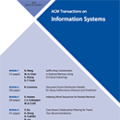In this paper we propose a variant of the induced suffix sorting algorithm by Nong (TOIS, 2013) that computes simultaneously the Lyndon array and the suffix array of a text in $O(n)$ time using $\sigma + O(1)$ words of working space, where $n$ is the length of the text and $\sigma$ is the alphabet size. Our result improves the previous best space requirement for linear time computation of the Lyndon array. In fact, all the known linear algorithms for Lyndon array computation use suffix sorting as a preprocessing step and use $O(n)$ words of working space in addition to the Lyndon array and suffix array. Experimental results with real and synthetic datasets show that our algorithm is not only space-efficient but also fast in practice.
翻译:在本文中,我们提出了一个由Nong引导的后缀排序算法(TOIS,2013年)的变体,该算法同时计算林登阵列和以美元(n)计时文本的后缀阵列,使用工作空间的$(n) $(gma + O(1)) 单词计算,其中美元为文字长度,美元(sigma美元)为字母大小。我们的结果改进了先前对林登阵列线性时间计算的最佳空间要求。事实上,所有已知的林登阵列计算线性算法都使用前处理步骤的后缀排序,除了林登阵列和后缀阵列外,还使用美元(n) 工作空间的后缀字。真实和合成数据集的实验结果显示,我们的算法不仅具有空间效率,而且在实践中也非常快速。





